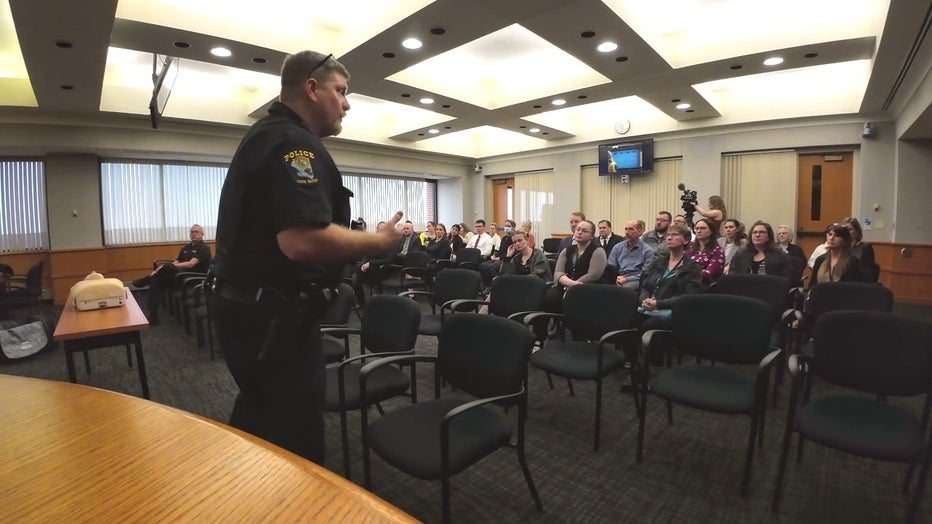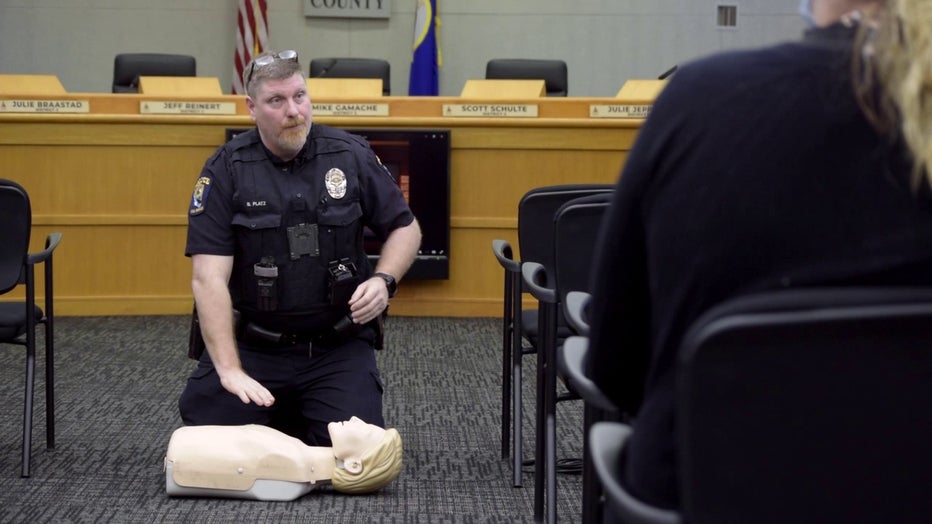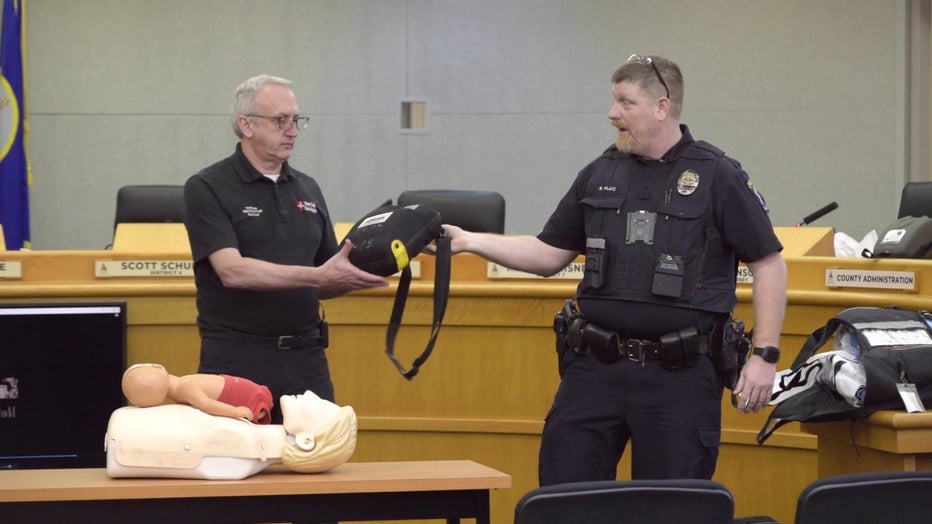Coon Rapids PD officer and cardiac arrest survivor teach thousands to save lives

Dedicated to saving lives
Bryan Platz is a police officer working the "heart beat".? His rolling suitcase of rescue CPR equipment and an advanced AED are the tools he carries in his squad car every day to save lives. But on this day, they?re his teaching tools.
COON RAPIDS, Minn. (FOX 9) - Bryan Platz is a police officer working the "heart beat". His rolling suitcase of rescue CPR equipment and an advanced AED are the tools he carries in his squad car every day to save lives. But on this day, they’re his teaching tools.
"What is CPR?" Platz barks to his audience of lawyers and staff members from the Anoka County Attorney’s Office.
For the next hour and a half, his mission is to break down fears, share knowledge, build skills, and ultimately, create a new tribe of life-saving CPR and AED evangelists.
"Okay, cardiac arrest is the number one killer in the United States without question," Platz explains to his attentive room of attorneys.
Cardiac arrest happens when the heart’s electrical rhythm is disrupted, causing the heart to suddenly stop pumping blood. It is not a heart attack, which occurs when a blocked artery restricts blood flow to the heart muscle.
The Centers for Disease Control, more commonly referred to as the CDC, says a person may suffer from a cardiac arrest if they:
- Collapse suddenly and lose consciousness
- Are not breathing or their breathing is ineffective or they are gasping for air
- Do not respond to shouting or shaking
- Do not have a pulse
The American Heart Association reports that more than 350,000 cardiac arrests happen outside the hospital every year. Research published in the academic journal Heart found that 80% of cardiac arrests occurred in the home and 20% in a public place. Oftentimes, that public place is where people work. The data leads Officer Platz to teach people that if they ever witness a cardiac arrest, it will very likely be someone they know.
"It’s what you do while waiting for people like us that makes the difference," Platz explained about the importance of reacting quickly.

Officer Platz instructs a class (FOX 9)
Once the heart stops beating, oxygenated blood is no longer reaching the brain and the body’s organs. Patients have about three minutes before damage starts to occur.
"Simply by doing the CPR and pushing on that chest, you’re pumping that pump," Platz explains. "It’s so critical to keep that oxygen going to the brain while you’re waiting for the help to get there."
Police and EMTs' response times can vary depending on traffic and distance, which is why Platz says it’s even more important for people to start CPR as soon as they recognize the symptoms.
"Usually, it takes a police officer, firefighter, or paramedic anywhere between five and ten minutes to get to the scene. If that patient’s not receiving that CPR and we start getting that brain oxygen five minutes into it, we’re two minutes too late," said Platz.
Without immediate CPR after a cardiac arrest, the American Heart Association reports only seven percent of patients survive. But with early delivery of CPR and a shock by an automatic external defibrillator (AED), data from the National Institutes of Health shows the survival rates are as high as 75%.
"People are afraid of CPR," says Platz about what’s known as the bystander effect, a term to describe witnesses not responding to a person collapsing from cardiac arrest.
"They’re afraid of doing more harm than good," said Platz. "If their heart’s not beating and they’re not breathing, that makes them dead. Their day can’t get any worse."
They’re all circumstances Officer Platz has witnessed firsthand. Eleven years ago he was called to McCarthy Auto World in Coon Rapids for a report of a mechanic who had collapsed in the shop. The mechanic’s name was Tim Hoffman.
"Tim’s coworker recognized he was not breathing. He doesn’t have a pulse, something needs to be done," Platz recalls of the incident. "He threw fear aside. He knew without something Tim was going to die and he started CPR."

Officer Platz demonstrates the proper technique. (FOX 9)
Platz and his partner arrived within five minutes when he took over the chest compressions on Hoffman while he was hooked up to a new AED that was assigned to his squad car. After the first shock, nothing appeared to happen and Platz kept pumping. Then just before the AED was ready for a second shock, Hoffman started to grunt.
"The second I took my hands off of him, he did this huge, big dramatic breath. And there he was, just instantly he was back," Platz proudly recalls of his first cardiac arrest save. "To see the dead come back to life, you know, having that at the end of my hands, I can’t even describe the feeling."
Eleven years later, Hoffman is still around to tell the story himself.
"If nobody had done anything in that amount of time, there was a good chance I wouldn’t have survived," he said while expressing his unending gratitude. "If you’re given a gift like this, you really need to look at it and do something with it."
Both Hoffman and Platz are now a two-man team for the Coon Rapids Heart Safe program. Together they teach CPR and AED rescue to organizations just like the Anoka County Attorney’s office. Platz estimates they’ve taught CPR to nearly 30,000 people.

But in this class, there was one last presentation. Holding up a newly retired AED unit, Platz had one final story to tell.
"This is the thing that restarted Tim’s heart," said Platz as he walked toward Hoffman with the AED. "Do you recognize this? Because this is the one that saved your life and now it’s yours."
It’s a gift that has been given daily for 11 years.
"I always said you meet friends in the strangest ways in life," said Platz, reflecting on his now close friendship with the man he saved. "I just happened to meet Tim sleeping on the job."

